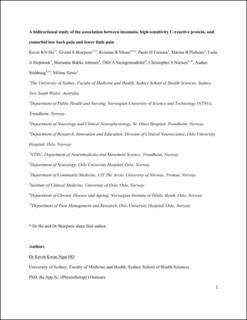| dc.contributor.author | Ho, Kevin Kwan Ngai | |
| dc.contributor.author | Skarpsno, Eivind S. | |
| dc.contributor.author | Nilsen, Kristian Bernhard | |
| dc.contributor.author | Ferreira, Paulo Herrique | |
| dc.contributor.author | Pinheiro, Marina | |
| dc.contributor.author | Hopstock, Laila Arnesdatter | |
| dc.contributor.author | Johnsen, Marianne Bakke | |
| dc.contributor.author | Steingrímsdóttir, Ólöf Anna | |
| dc.contributor.author | Nielsen, Christopher Sivert | |
| dc.contributor.author | Stubhaug, Audun | |
| dc.contributor.author | Simic, Milena | |
| dc.date.accessioned | 2023-04-18T13:44:00Z | |
| dc.date.available | 2023-04-18T13:44:00Z | |
| dc.date.created | 2022-04-14T14:13:44Z | |
| dc.date.issued | 2022 | |
| dc.identifier.citation | Scandinavian Journal of Pain. 2022, 23 (1), 110-125. | en_US |
| dc.identifier.issn | 1877-8860 | |
| dc.identifier.uri | https://hdl.handle.net/11250/3063631 | |
| dc.description.abstract | Objectives - To examine the possible bidirectional association between insomnia and comorbid chronic low back pain (LBP) and lower limb pain and to explore whether high-sensitivity C-reactive protein (hsCRP) amplifies these associations.
Methods - We calculated adjusted risk ratios (RR) with 95% confidence intervals (CI) for the development of insomnia and mild-to-severe chronic LBP and lower limb pain at 11 years follow-up in participants aged ≥32 years and with hsCRP ≤10 mg/L at baseline in 2007–2008: 3,714 without chronic LBP or lower limb pain (sample 1) and 7,892 without insomnia (sample 2).
Results - Compared to participants without chronic pain, participants with comorbid chronic LBP and lower limb pain had a RR of insomnia of 1.37 (95% CI 1.12–1.66). Compared with participants without insomnia, participants with insomnia did not have an increased risk of comorbid chronic LBP and lower limb pain (RR: 1.06, 95% CI 0.76–1.46); however, participants with insomnia had a RR of chronic LBP of 1.20 (95% CI 1.02–1.42). There was no strong amplifying effect of elevated hsCRP (3.00–10.0 mg/L) on these associations.
Conclusions - These findings suggest that elevated hsCRP does not amplify the associations between insomnia and mild-to-severe chronic LBP and lower limb pain. Further research using data on the temporal relation between insomnia, chronic pain, and inflammatory responses are required to fully understand the causal pathways. | en_US |
| dc.language.iso | eng | en_US |
| dc.publisher | De Gruyter | en_US |
| dc.title | A bidirectional study of the association between insomnia, high-sensitivity C-reactive protein, and comorbid low back pain and lower limb pain | en_US |
| dc.title.alternative | A bidirectional study of the association between insomnia, high-sensitivity C-reactive protein, and comorbid low back pain and lower limb pain | en_US |
| dc.type | Peer reviewed | en_US |
| dc.type | Journal article | en_US |
| dc.description.version | acceptedVersion | en_US |
| dc.rights.holder | Authors accepted manuscript. © 2022 Walter de Gruyter GmbH, Berlin/Boston | en_US |
| dc.source.pagenumber | 110-125 | en_US |
| dc.source.volume | 23 | en_US |
| dc.source.journal | Scandinavian Journal of Pain | en_US |
| dc.source.issue | 1 | en_US |
| dc.identifier.doi | 10.1515/sjpain-2021-0197 | |
| dc.identifier.cristin | 2017304 | |
| cristin.ispublished | true | |
| cristin.fulltext | postprint | |
| cristin.qualitycode | 1 | |
